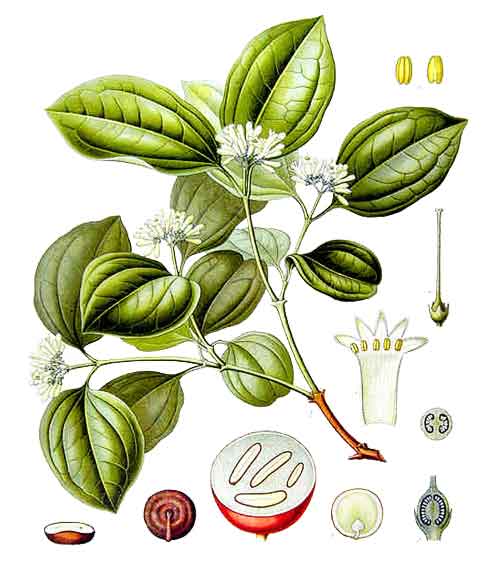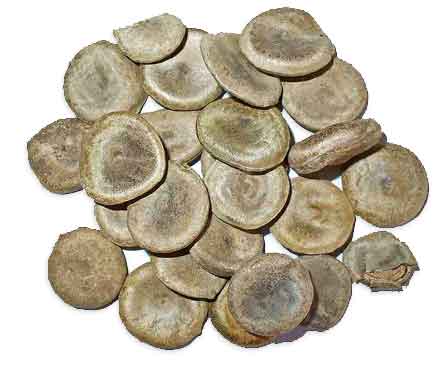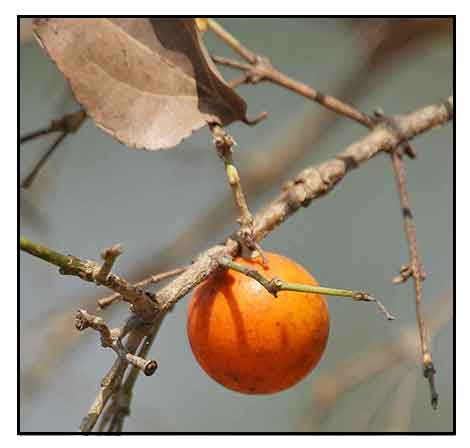 Botany Botany
Strychnine plant is a medium-sized, deciduous tree, growing to a height of 10 meters, with a straight, thick trunk. Leaves are leathery, smooth, opposite, entire, shiny, broadly elliptic or ovate, 7.5 to 15 centimeters long and 6 to 8 centimeters wide, 5-nerved, blunt or rounded at the base, and pointed at the tip. Flowers are greenish-white, numerous, small, and borne on small, terminal hairy cymes 2.5 to 5 centimeters in diameter. Calyx is small, with 5 teeth. Corolla is tubular or funnel-shaped, with 5 reflexed, short limbs. Fruit is a berry, smooth, indehiscent, orange when mature, round and 3 to 5 centimeters in diameter. Rind is a shell-like pulp with 2 to 5 seeds embedded in it. Seeds are disc-shaped, nearly flat, 10 to 30 millimeters in diameter, 4 to 6 millimeters thick, shining, light silvery-grey, and covered with closely appressed hairs, odorless but quite bitter.
Distribution
- Introduced to the Philippines, - nowhere spontaneous.
- Cultivated in the College of Agriculture, Los Banos, Laguna.
- Native of Sri Lanka, India, and Burma.
Constituents
- It is a major source of the highly poisonous alkaloids: strychnine and brucine.
- The alkaloids are the major components of the species.
- Seeds contain strychnine (1.5%) and brucine, and a glucoside, loganine.
- Leaves contain brucine 1.6%, strychnine 0.25%.
- The bark, wood and old roots contain strychnine and brucine in varying amounts.
- Pulp of the fruit contains a glucoside – loganin.
- Fixed oil of the seeds contain oleic, palmitic, arachic, butyric acid, among other, plus some amounts of strychnine and brucine.
- Study isolated a colored monquaternary bisindole alkaloid from the roots.
(19)
- Study yielded 22 compounds from an antitumor active fraction: brucine, strychnine , brucine-N-oxide, strychnine-N-oxide, strychnine methiodide, pseudobrucine, pseudostrychnine, icajine, vomicine, novacine, ferulic acid, caffeic acid ethyl ester, cinnamic acid, protocatechuic acid, salicylic acid, gallic acid, vanillic acid, ursolic acid, β-simiarenol, β-sitosterol, and daucosterol. (see studies below)
- Study isolated 13 alkaloids from the seeds:
strychnine, beta-colubrine, pseudostrychnine, strychnine N-oxide, brucime, brucine N-oxide, novacine, icajine, vomicine, isostrychnine, isobrucine, isobrucine N-oxide and isostrychnine N-oxide
 Properties Properties
- Strychnine, the chief active principle, is one of the most powerful poisons that act on the nervous and muscular systems. It can cause sudden tetanic tonic contraction.
- The toxic properties of the alkaloids have limited its wider use.
- Seed is nervine, stomachic, tonic, aphrodisiac, stimulant (cardiac, respiratory, spinal).
- Strychnine is stimulant to the respiratory and vasomotor centers.
- Bark is employed as tonic and febrifuge.
- In excessive doses it is virulently poisonous, producing tetanic convulsions from simultaneous stimulation of the motor and sensory ganglia of the spinal cord.
- Brucine resembles strychnine, but is less poisonous, causing paralysis only of the peripheral motor nerves.
- Bark considered tonic and febrifuge.
- Used in pruritus and as local anodyne in external ear inflammations.
Parts utilized
Seeds, bark, roots, leaves.
Seeds are removed from the fruit when ripe; then, cleaned, dried and sorted.
Uses
Folkloric
- Mixtures of Nux Vomica were used as gastrointestinal stimulants, increasing appetite by stimulation of peristalsis. Strychnine also increase the flow of gastric juice.
- Alternative medicine systems have suggested strychnos for a wide range of medical problems: liver cancer, various gastrointestinal complaints (abdominal pain, vomiting, constipation, intestinal irritation, heartburn), insomnia, nervous conditions, menopausal problems.
- In Indian pharmacopoeia, used in paralytic and neuralgic affections, in atonic diarrhea and chronic dysentery, and in habitual constipation dependent on color torpor, in rectal prolapse, urine incontinence, spermatorrhea, in cases of debility or inactivity of the spinal system of nerves. Also used in intermittent fevers, epilepsy, diabetes, anemia, and chlorosis.
- In Chinese medicine, used for liver cancer treatment.
- Powdered seeds used for atonic dyspepsia.
- Seeds used in rheumatism, paralysis, asthma, diabetes, piles.
Poison / Toxicity
- Although widely used in medicine before World War II, there are no present uses in modern western medicine.
- It is a deadly poison with a lethal dose of about 30 to 120 mg in humans.
-
Doses of 5 mg or more (as little as one seed) can cause anxiety, restlessness, painful convulsions, respiratory difficulty and even death from suffocation or exhaustion.
- In case of poisoning, a stomach pump should be used immediately and potassium permanganate given to inactivate strychnine. There is no specific antidote. Treatment is supportive. Convulsions can be controlled by anesthetics.
 Studies Studies
• Cancer Treatment Claims: Available scientific evidence does not support claims that Strychnos nux-vomica is effective in treating cancer, relieving the side effects of conventional cancer treatment, or treating any other condition.
• In Vitro Cytotoxicity Study: Study showed the methanol extract of Strychnos nux-vomica failed to show any significant cytotoxicity activity. Study also showed the extract of S nux-vomica did not have any potential to arrest human MCF-7 breast cancer cells. (3)
• Anti-Tumor: Study yielded 22 compounds from an antitumor active fraction. (See Constituents above) Five compounds - strychnine-N-oxide, strychnine methiodide, pseudobrucine,icajine, and ursolic acid showed inhibitory activity towards human lung cell line A549.
• Inhibition of Iron-Induced Lipid Peroxidation: Study of alcohol extract of Snv on FeSO4-induced lipid peroxidation in vivo showed dose-dependent inhibition, probably through a mechanism of chelation of Fe++/Fe+++ ion in the system and not by trapping the hydroxyl radicals. It also significant maintained the hepatic glutathione content in a time- and dose-dependent manner. (6)
• Helicobacter Pylori Treatment: Study investigated the influence of Nux vomica and Calendula officinalis on HB-EGF-like growth factor gene expression. Data showed the ethanolic solution of both drugs were potent inhibitors of H. pylori induced gene expression. (8)
• Antiproliferative / Cytotoxic: Snv root extract exhibited anti-proliferative activity in a dose- and time-dependent manner on the human MM (multiple myeloma)-cell line, RPMI 8226. The extract treated cells showed significant features of apoptosis. The activity could be attributed to the a antiproliferative and cytotoxic activities could be attributed to the alkaloids strychnine and brucine. (9)
• Brucine / Apoptotic Effect: Study evaluated the cytotoxic effects of four alkaloids in Strychnos nux-vomica - brucine, brucine N-oxide, strychnine, and isostrychnine - on human hepatoma cells (HepG2) through a 3-(4,5-dimethylthiazol-2-yl)-2,5-diphenyl-tetrasolium bromide (MTT) assay . Of the four alkaloids, brucine exhibited the strongest toxic effect, with HepG2 cell apoptosis, possibly involving Ca++ and Bcl-2 mediated mitochondrial pathway. (10)
• Anti-Inflammatory / Antioxidant: Study showed an ethanol extract to possess potent anti-inflammatory and antioxidant property without detectable adverse effect. (11)
• Brucine / Analgesic / Ant-Inflammatory: Study of brucine and brucine N-oxide extracted from the seeds of Snv showed significant protective activities against thermic and chemical stimuli. Brucine N-oxide showed stronger inhibitory effect than brucine in the carrageenan-induced paw edema model, with both significantly inhibiting the release of prostaglandin E2. The results suggest the involvement of central and peripheral mechanisms in pain modulation and anti-inflammatory effects. (12)
• Immunomodulatory: Study evaluated the possible immunomodulatory effect on induction of ovalbumin (OVA)-specific IgE antibody response in a murine model. Results confirmed the suppressive activity of Snv on allergen-specific IgE antibody response and suggest an application for allergic conditions.
• Antidiabetic / Free Radical Scavenging / Seeds: Study evaluated a methanolic extract of Strychnos nuxvomica in alloxan induced diabetic model. Results showed a dose dependent effect attributed to increased uptake of glucose at the tissue level or by an increase in pancreatic beta cell function due to inhibition of intestinal absorption of glucose. Extract also showed antioxidant activity in the DPPH assay.
(14)
• Antisnake Venom Activity / Seed: Study evaluated a whole seed extract effectively neutralized Daboia russelii venom induced lethal hemorrhage, defibrinogenating, PLA2 enzyme activity and Naja kaouthia venom induced lethal, cardiotoxic, neurotoxic, PLA2 enzyme activity. The actual mechanism of SNVNF induced venom neutralization was not clear but may be due to inactivation of of venom proteins toxins. (15)
• Larvicidal / Culex quinquefasciatus: Study evaluated the larvicidal activity of various leaf extracts of S. nuxvomica against third instar larvae of Culex quinquefasciatus. Results showed the ethyl acetate extract to be the effective larvicide, and suggests a potential for use in larval mosquito population control. (16)
• Purificatory Measures: Ayurveda has long advocated that nux vomica seeds be administered in therapeutics only after going through purificatory measures. All six media for purification (cow's milk, cow's ghee, thin gruel, castor oil and fresh ginger juice). The study used cow's urine and cow's milk as media alone or in combination. Maximum reduction in strychnine and brucine contents was found when seeds were purified by keeping them in cow's urine for seven days followed by boiling in cow's milk for three hours. (17)
• Antimicrobial: Study evaluated various leaf extracts of S. nuxvomica and C. angustifolia for antimicrobial activity. The n-butanol extract of both plants inhibited all the bacterial and fungal test strains, comparable to standard antibiotics. (18)
• Inhibition of Corrosion of Mild Steel: Study showed the seed extract of Kuchla (S. nuxvomica) could serve as an effective inhibitor of corrosion of mild steel in hydrochloric acid media (20)
Availability
Wild-crafted.
|

![]()



 Botany
Botany Properties
Properties Studies
Studies 